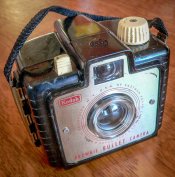blockend
Member
Looking at YouTube videos of box cameras, I began to wonder when the last traditional box style cameras were made? The first camera I can remember was my parent's Coronet box camera in the early sixties, and I get the feeling box cameras were old hat even then.
They seem to have evolved into basic viewfinder cameras, with the Brownie name being given to various fixed lens point and shoot cameras and faux TLRs. Does anyone know when the last traditional box style cameras were made? I'm aware new variants have been produced since. The Coronet Company of Birmingham, England, appears to have been dedicated* to box camera production, and they ceased trading in 1967. I take that date to be the end of the true, volume produced box camera, unless anyone knows differently?
*Coronet made bakelite P&S cameras concurrent with box cameras in their final years as far as I can tell.
They seem to have evolved into basic viewfinder cameras, with the Brownie name being given to various fixed lens point and shoot cameras and faux TLRs. Does anyone know when the last traditional box style cameras were made? I'm aware new variants have been produced since. The Coronet Company of Birmingham, England, appears to have been dedicated* to box camera production, and they ceased trading in 1967. I take that date to be the end of the true, volume produced box camera, unless anyone knows differently?
*Coronet made bakelite P&S cameras concurrent with box cameras in their final years as far as I can tell.
Last edited:






